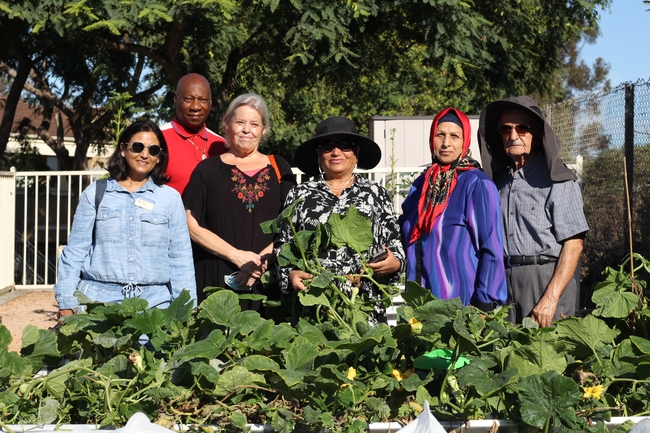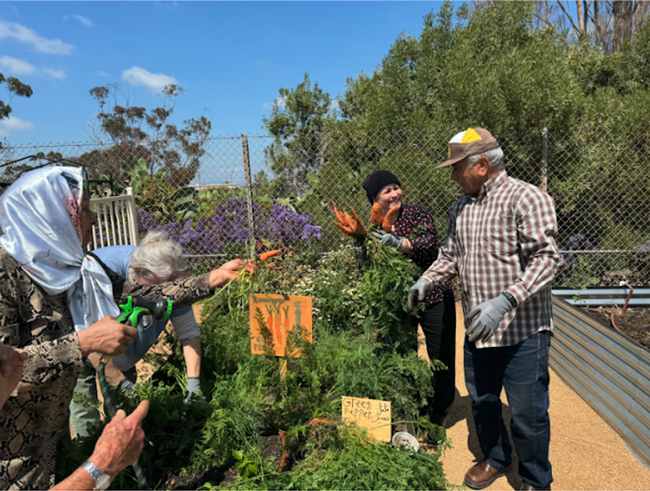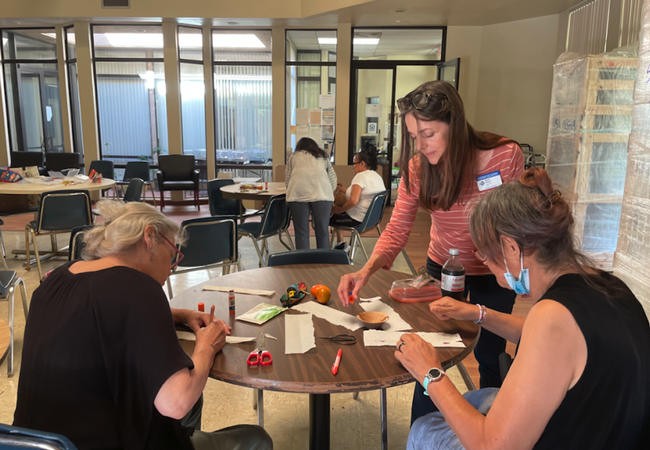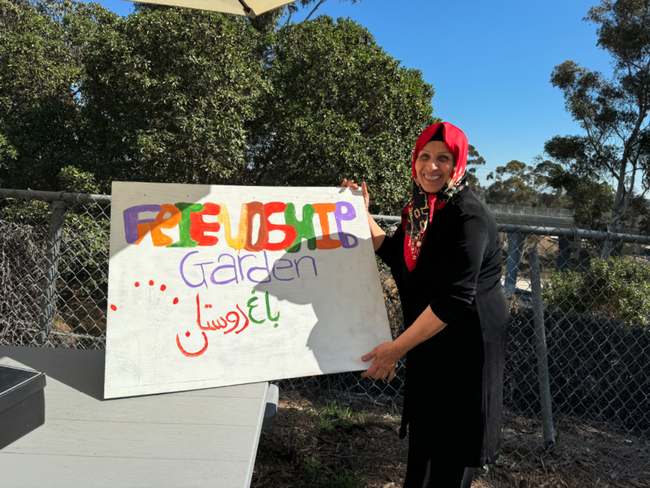
Posts Tagged: food
UC Master Gardener of San Diego County’s ‘labor of love’ improves health of older adults
The Belden Village Apartments in Clairemont Mesa East of San Diego is home to a diverse population of older adults. Shital Parikh, a UC Master Gardener of San Diego County, took the initiative to build a garden that grows food and encourages residents to spend more time outdoors, getting their hands dirty alongside neighbors.
Almost a year ago, Parikh – a UC Master Gardener since 2014 – proposed to develop a community garden within the low-income residential facility with the intention that the residents would manage it independently overtime. When the San Diego Housing Commission (SDHC) and County of San Diego approved the proposal, Parikh moved swiftly to break ground on what is now the Belden Community Garden.
“The Belden Community Garden is a labor of love,” Parikh said. “One that has been made possible thanks to the knowledge and support gained from the UC Master Gardener Program and the invaluable support from Amy Zink from the County of San Diego Health and Human Services Agency.”
Breaking ground for a community garden
In September 2023, interested residents at the Belden Village Apartments gathered to learn of the project and understand how they can be involved. In October, the County of San Diego received a donation from Home Depot which included garden beds, and the materials needed to build them. All of which were donated to Parikh to establish the Belden Community Garden.
“This project has received approved funding from our partners and there has not been any out-of-pocket expense,” said Parikh.
In preparation for the garden beds, residents teamed up with more than a dozen UC Master Gardeners of San Diego County to learn various gardening skills. Some taught residents how to create seed tape, making it easier to plant seeds in an organized manner, the basics of vegetable gardening and food prep classes as well.
In January 2024, 13 garden beds were installed and ready for planting. In March, residents enjoyed their first harvest of vegetables and leafy greens by hosting a salad-making luncheon where everyone could taste the fresh produce grown on-site.
“The residents are at the heart of this, and it's been a joy to see them come together across different languages and cultures, sharing in the harvest and learning alongside us,” said Parikh.
Other than English, there are four primary languages spoken in the residential community, including Spanish, Arabic, Farsi and Vietnamese. All garden signs communicate the names of crops in these primary languages – a nod to the residents who helped establish and maintain the garden, which also features crops important in the various cultures.
Residents at the ‘heart' of it all
The Belden Community Garden has two residential garden coordinators, Art Dawson and Lisa Hillman, who are responsible for watering and general maintenance of the garden. Neither Dawson nor Hillman had prior gardening experience.
In the three years that Hillman has been living at the Belden Village Apartments, this is the first time she's participated in a community effort like the garden. “I didn't come outside or interact with neighbors much – but since I started volunteering here, I see so many people and I know more people in my community,” said Hillman, who described the various colors of squash – her favorite vegetable, so far – grown and harvested in the garden.
Dawson, in contrast, isn't a big fan of squash and prefers greens instead. “I'm African American, so I'm all about the collard greens,” said Dawson. Learning as he goes, Dawson said his primary job is managing irrigation.
“I've never gardened before in my life. But I like helping out and working with my hands,” he said. “I kind of like it. It keeps me busy, and I love seeing how everything grows from a tiny seed.”
Shahnaz Roshanoi, a resident whose native language is Farsi, said she was so happy when the garden came to fruition. Roshanoi maintains a garden of her own using the limited space that surrounds her apartment with plants reaching as tall as seven feet. Since the community garden was established, Roshanoi has been an active volunteer, sharing her extensive gardening knowledge with others and inviting more residents to join the fun.
Parikh's effort inspires development of more community gardens
During her earlier days as a UC Master Gardener, Parikh taught gardening via Zoom because of COVID-19. Parikh focused on teaching low-income residents, who are often at a disadvantage in accessing affordable healthy food options. Her gardening projects have all benefitted from her 10-plus years of experience in companion planting and crop rotation, pollinator gardens and native plants.
“Watching the garden evolve has been incredibly rewarding, and I can't wait to see how it continues to thrive!” said Parikh.
With generous support from the UC Master Gardeners Program of San Diego County, County of San Diego, SDHC's Achievement Academy, and the Del Mar Mesa Garden Club, the Belden Community Garden teaches residents how to grow their own food, enjoy it, and live healthier, happier lives.
The success and impact of the Belden Village community has inspired two more community gardens in low-income resident facilities located in the Mesa Valley and Otay Mesa neighborhoods in San Diego.
“I do what I can and then leave the rest to divinity,” Parikh said. “Time and again, help has found its way, or maybe it's simply a matter of trusting the process and staying consistent.”
The UC Master Gardeners of San Diego County work to expand the love of gardening and improve food security across the county. You can support their efforts by donating at this link here: https://give.ucanr.edu/forms/SanDiego-MG
Food Waste Project: Emma Vazquez on the Mike!
Over the Thanksgiving holiday week, American consumers tossed out about 200 million pounds of...
Feeding grazing cattle seaweed cuts methane emissions by almost 40%
Findings offer solution for more climate-friendly cattle farming
Seaweed is once again showing promise for making cattle farming more sustainable. A new study by researchers at the University of California, Davis, found that feeding grazing beef cattle a seaweed supplement in pellet form reduced their methane emissions by almost 40% without affecting their health or weight. The study was published Dec. 2 in Proceedings of the National Academy of Sciences.
This is the first study to test seaweed on grazing beef cattle in the world. It follows previous studies that showed seaweed cut methane emissions 82% in feedlot cattle and over 50% in dairy cows.
How much methane do cattle produce?

“Beef cattle spend only about three months in feedlots and spend most of their lives grazing on pasture and producing methane,” said senior author Ermias Kebreab, professor in the Department of Animal Science. “We need to make this seaweed additive or any feed additive more accessible to grazing cattle to make cattle farming more sustainable while meeting the global demand for meat.”
Difficulty in reducing methane emissions from cattle
Kebreab said that daily feeding of pasture-based cattle is more difficult than feedlot or dairy cows because they often graze far from ranches for long periods. However, during the winter or when grass is scarce, ranchers often supplement their diet.
For this study, researchers divided 24 beef steers (a mix of Angus and Wagyu breeds) into two groups: one received the seaweed supplement, and the other did not. Researchers conducted the 10-week experiment at a ranch in Dillon, Montana. Since these were grazing cattle, they ate the supplement voluntarily, which still resulted in a nearly 40% cut in emissions.
Most research studies to reduce methane emissions using feed additives have taken place in controlled environments with daily supplements. But Kebreab noted in the study that fewer than half of those methods are effective for grazing cattle.
“This method paves the way to make a seaweed supplement easily available to grazing animals,” said Kebreab. “Ranchers could even introduce the seaweed through a lick block for their cattle.”
Kebreab said pastoral farming, which includes large grazing systems, supports millions of people around the world, often in areas vulnerable to climate change. This study suggests a way to make cattle grazing better for the environment, while playing a role in fighting climate change.
A related article in the same PNAS issue highlights the need to improve the efficiency of livestock production in low- and middle-income countries using better genetics, feeding and health practices. UC Davis Professor and Cooperative Extension Specialist Alison Van Eenennaam, the article's author, said it is the most promising approach to meet the global demand for meat while limiting greenhouse gas emissions.
Other authors of the seaweed study include UC Davis postdoctoral researchers Paulo de Méo Filho and John-Fredy Ramirez-Agudelo.
The research was supported by Matador Ranch in Dillon, Montana.
This article was first published on the UC Davis news site.
Desert Organic Research and Food Safety Workshop set for Dec. 4 in Holtville
The "Advances in Southwest Desert Agriculture Research, Organic Production and Food Safety" workshop is scheduled for Dec. 4 in Holtville. This event will showcase cutting-edge research and practical organic farming strategies tailored to California's unique desert environment.
The symposium will feature presentations from University of California Cooperative Extension advisors and other experts.
The agenda covers a range of critical topics, including insect pest management in low desert agriculture, weed management strategies for guayule seedlings, summer cover crops for soil health and disease management, integrated pest management for onion diseases, predicting sugar beet cyst nematode suppressiveness, and microbial risk assessment of soil amendments in organic romaine lettuce.
“These presentations will provide valuable insights into improving desert vegetable production, irrigation efficiency, and food safety practices specific to our region,” said co-organizer Jimmy Nguyen, University of California Cooperative Extension food safety and organic production area advisor for Imperial and Riverside counties.
“This symposium presents an excellent opportunity to learn about the latest research findings directly applicable to Imperial County agriculture, gain practical knowledge to enhance your agricultural practices, and network with fellow professionals and researchers in the field.”
The UC Cooperative Extension team aims to foster the exchange of ideas and promote the advancement of agricultural practices in the community.
“We encourage everyone involved in growing crops in Imperial County to attend this informative event and contribute to the ongoing dialogue on agricultural innovation in the Southwest desert region,” Nguyen said.
The workshop will be held at Barbara Worth Country Club, 2050 Country Club Dr, Holtville, CA 92250. Register at https://surveys.ucanr.edu/survey.cfm?surveynumber=43924.
For more information, please contact UC Cooperative Extension advisors Jimmy Nguyen, cgnguyen@ucanr.edu; Philip Waisen, pwaisen@ucanr.edu; Ali Montazar, amontazar@ucanr.edu; or Oli Bachie, obachie@ucanr.edu; or call (442) 265-7700.
CFHL, UC and UCCE Alameda team up with UCSF for Food Farmacy
Green peas, orange carrot cubes and squares of white tofu sizzled as they were stirred into brown rice in an electric frying pan. “Smells good,” commented a man walking to the fresh produce display.
Every week UC San Francisco Benioff Children's Hospital in Oakland gives away fresh produce to patients and community members at its Food Farmacy to improve food security in the community. On Nov. 14, nutrition experts from UC Cooperative Extension and CalFresh Healthy Living, UC joined UCSF colleagues to encourage Oakland residents to eat fresh fruits and vegetables for better health.
Tuline Baykal, CalFresh Healthy Living, UC Cooperative Extension program supervisor in Alameda County, and CFHL, UC community educators Mercy Mumba, Yolanda Silva and Mariela Wajler showed visitors how to prepare dishes that could be easily made from fresh produce. Mumba and Wajler cooked tofu fried rice while Silva tossed slices of persimmon, dried cranberries and spinach together before drizzling an orange juice dressing on top. They handed out recipes with samples of the foods.
Alexa Erickson, UCCE nutrition advisor for Alameda and Contra Costa counties, was on site to answer nutrition questions.
Community members could choose from a generous array of free leafy greens, cucumbers, red cabbage, carrots, potatoes, tomatoes, citrus, red onions, bell peppers, chicken and other grocery items.
Through their collaboration, the UCSF health professionals and UC ANR nutrition educators hope to highlight the role of food in healthy living and California farms in producing healthy living options.
“A partnership with UCSF Benioff Children's Hospital Clinics presents opportunities for us to expand our delivery of CalFresh Healthy Living, UC education to parents in places they are going to receive health care for their children – making this vital nutrition education more accessible,” said Andra Nicoli, CalFresh Healthy Living, UC program and project policy analyst based at UC Davis College of Agriculture and Environmental Sciences.
Nicoli worked with Antonio De Wolk, UCSF's assistant director of content strategy, and Rigoberto Del Toro, manager of the Food Farmacies at UCSF Benioff Children's Hospital Oakland, to coordinate UC ANR's participation in the Food Farmacy.











